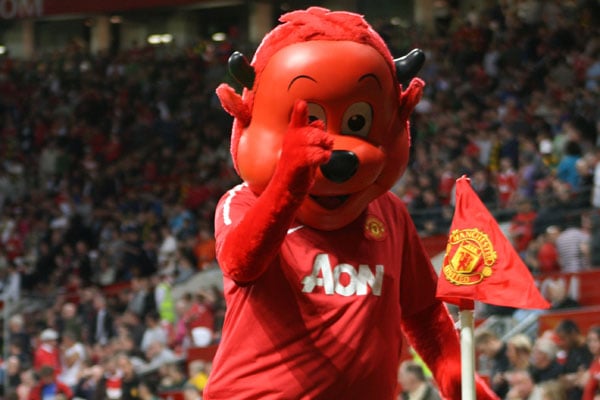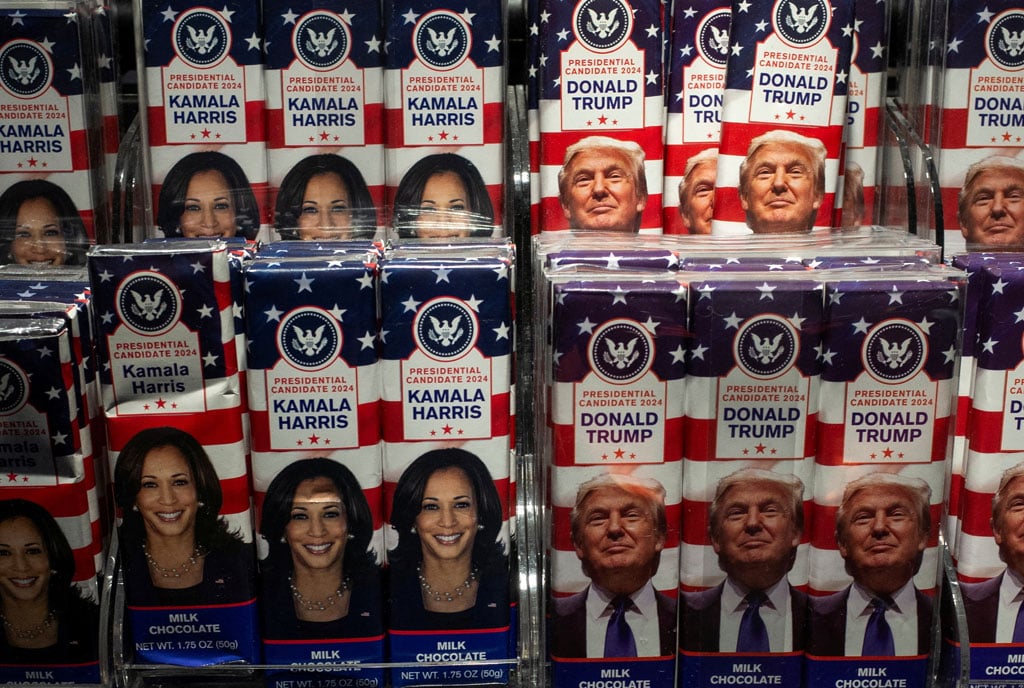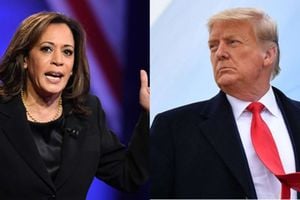Prime
The amazing history of football clubs’ nicknames

Red Devil at work. ‘Red Devil’ the mascot entertains fans at Old Trafford. Photo/Agencies
What you need to know:
- English Premier League side Everton, from Liverpool, adopted The Toffees from a toffee shop near its ground. The shop was called ‘Mother Noblett’s’ and sold mint.
- Fifteen years later, Norwich City completed its canaries transformation with a new badge, putting a canary on the club’s crest.
Football, a game of thrills, spills and chills is incomplete without identity and if badges, logos and slogans made identity, fans would not get down to it all without nicknames for their clubs. In nickname, fans set the ultimate fun.
Express are called The Red Eagles and arch-rivals SC Villa chose for themselves the rooster to contend with the eagle, just like Liverpool are The Reds where cross-town rivals are also called The Blues.
Where sometimes there are aesthetic value in a nickname, other times it goes much deeper into history of places. And that includes Everton’s official nickname, The Toffees, and so many other clubs world over.
The nicknames, often chosen by fans, are arrived at for different reasons, like KCCA being proud of their identity of keeping the city clean, thus The Kasasiro Boys (Garbage Collectors).
English Premier League side Everton, from Liverpool, adopted The Toffees from a toffee shop near its ground. The shop was called ‘Mother Noblett’s’ and sold mint. According to Everton records, in the 1950s and 1960s, a woman dressed up as ‘Mother Noblett’ would walk around the edge of the pitch and throw toffees into the crowd, helping the nickname to develop.
But some clubs like Hull City who have played in orange and black for the majority of their existence, or Newcastle with their black and white stripes go the simple ride. ‘The Tigers’ is as easy a jump as Hull City’s stripes so is ‘The Magpies’ for Newcastle.
For many, hearing commentators call Sheffield Wednesday ‘The Owls’ gives the impression that probably the English town had plenty the peculiar night birds associated with bad omens doing nocturnal rounds and hooting.
But record of the Championship side has nothing like it. There isn’t even anecdotes suggesting that, like owls, some of the Wednesday players, officials or fans were spotted spinning their head around 360 degrees on their shoulders.
“Instead it’s a lot more simplistic than that – their home ground of Hillsborough was built in the Olwerton district of Sheffield,” says Football Stadiums, a soccer website.

Colourful. Milan’s The Rossoneri. PHOTO/AGENCIES
Canaries gives Norwich kit idea
Fans of English Championship table toppers Norwich did not pick on the canaries moniker after their bright yellow and green trim kit, but the club is actually the one that redesigned itself long after the nickname had nestled in the hearts of the fans.
Originally, the club was nicknamed the Citizens (“Cits” for short), and played in light blue and white halved shirts. But in February 1907, the canaries nickname – after the brightly coloured yellow birds that are famous for breeding in the city – turned en vogue. A new kit design was commissioned and launched the following season.
Fifteen years later, Norwich City completed its canaries transformation with a new badge, putting a canary on the club’s crest.
Meanwhile, Arsenal has had so many names before it settled for one resonating with its nickname. Originally called Dial Square when it was formed by workers from a munitions factory in 1886, many felt the name didn’t work for a football club so they became Royal Arsenal just a month after forming.
In 1893 they became Woolwich Arsenal and in 1914 when, after moving to north London, it didn’t make sense to keep the ‘Woolwich’ part in their name any more. They became ‘The Arsenal’ and later simply Arsenal, but the links to their past were never forgotten. The club’s origins from a munitions factory is still remembered today in their nickname of ‘The Gunners.’
Football Stadiums also explains a similar tale about why West Ham United are known as ‘The Hammers’. The side was formed in 1895 as Thames Ironworks by the local ironworks’ foreman and the team was made up of its employees. To this day, they not only have that nickname but also have two crossed hammers on their crest.
Are Bolton pigs?
If you do not like pigs or whatever is associated with this animal, you probably have severe dislike for Bolton Wanderers, aka ‘The Trotters.’
While the nickname might suggest laziness of roaming around – as in Wanderers – Wikipedia, the online encyclopedia, has this to say: “The club’s nickname of ‘The Trotters’ has several claimed derivations; that it is simply a variation on ‘Wanderers,’ that it is an old local term for a practical joker, or that one of the grounds used before the club settled at Pikes Lane resided next to a piggery, causing players to have to “trot” through the pig pens.
Take your pick, which one best describes Bolton’s moniker? Just know this, pigs are good animals.

Meanwhile, there is this one, West Bromwich Albion, who proudly go around calling themselves ‘The Baggies.’ Why? Were they perhaps playing in oversized tent-like shorts?
Some sites indicate that money from supporters used to be collected into big bags. Supporters reportedly took to shouting, “Here come the bag men!” which developed into “Here come the baggies!” over time.
The ridiculous nicknames
While some fans might be proud of their clubs’ nicknames likes The Bluebirds (Cardiff City) or The Swans (Swansea City), others cringe at the thought of their own quite ludicrous and stupid nicknames. Charlton Athletic are called ‘The Addicks’ – a bastardisation of the word ‘haddock’ (lean white flesh of fish) and was given to them because the ground was built near to a well-known fish and chip shop.
Take Kidderminster Harriers, as an example. Kidderminster was the home of the modern carpet industry, so the football club took on the nickname of ‘The Carpetmen’. Similarly, Wycombe was the home of the local furniture making industry so Wycombe Wanderers became known as ‘The Chairboys’.
Football Stadiums indicates that Hartlepool United are the owners of one of the game’s most ridiculous nicknames and accompanying stories. During the Napoleonic War, tensions were high in the coastal town of Hartlepool. Suspicion was thrown on anyone that wasn’t immediately recognised by someone who could vouch for them.
“That is the rationale for why the citizens of Hartlepool decided to hang a monkey, believing it to be a French spy. Whether that story is true or not is largely irrelevant – what we do know is that the club continues to be known as ‘The Monkey Hangers’ to this day,” the site says.
Why are Sunderland called Black Cats?
Forget ‘The Owls’ of Sheffield Wednesday. Sunderland is the thing. While in Africa many dread the thought of owls, it is actually the fear of an imaginery black cat that gave Sunderland its bizarre nickname. The tales are not even close to some curse or witches, but it is said that during the Napoleonic Wars, there were four gun batteries located on the mouth of the city’s River Wear. It was officially named the John Paul Jones Battery but one night one of the people who manned it fled screaming, saying he heard the howling of a black cat that was similar to the sound of the ‘devil himself.’ The battery was henceforth known as the Black Cat Battery and the animal became associated with the city.
The Red Devils
After the Munich Air Crash of 1958, Manchester United manager Matt Busby started on rebuilding but found that the famous ‘Matt’s Babes’ seemed inappropriate so a new name was sought. Matt’s Babes had been born from the grooming programme Busby had undertaken years earlier by promoting youngsters into the first team. English rugby club Salford had toured France in the 1930s wearing red shirts and became known as ‘The Red Devils.’ Busby liked the sound of it, thinking a devil was more intimidating to opponents than angelic babes. He declared United were also ‘The Red Devils’ and soon the club began incorporating the devil logo in match programmes and scarves. In 1970, the club badge was redesigned, but now with a devil in the centre holding a pitch-fork.
Chelsea Pensioners
English Premier League side Chelsea were called ‘The Pensioners’ until the mid 50s because of their association with the famous Chelsea Hospital, home to British war veterans – the Chelsea Pensioners. This association continues to this day with loyal pensioners being given eight seats for every home game at Stamford Bridge. Club is also called The Blues.
Deportivo Alaves’ nickname comes from the Basque language. ‘Baba’ references fava beans, and zorro means ‘sack’. So, in an allusion to the large amounts of favas that were produced in the Alava province, Alaves are literally called ‘the beanbags’.
In the Valencian style of speaking, saying ‘che’ is the same as saying ‘hey’. ‘Levantinos’, who hail from the east coast of Spain, are easily identifiable throughout the rest of the country by their usage of this slang term.
In 1967, Villarreal (who play in yellow) were promoted to Spain’s third division. Around that time, a band called Los Mustangs covered ‘Yellow Submarine’, originally by the Beatles. The cover became popular in Spain, and so, Villarreal became known as ‘the Yellow Submarine’!
Bayer Leverkusen was founded by employees of the pharmaceutical company Bayer AG, which which is alluded to in their nickname (which translates to ‘The Company XI’).
Koln’s nickname is a reference to the club’s mascot, a male goat named Hennes who, in turn, was named after former Koln player and manager Hennes Weisweiler.
Augsburg is known as the Fuggerstadt (the Fugger city). It acknowledges the Fugger family, who were a notable business and banking entity during the Renaissance period.
Paderborn don’t really have a nickname, though the club still have an interesting backstory. For many years, Paderborn had two football clubs – TuS Schloss Neuhaus and Paderborn. They eventually merged into TuS Paderborn/Neuhaus in 1985, and officially changed their name to SC Paderborn 07 in 1997. The 07 refers to 1907, the year TuS Schloss Neuhaus was founded.
Hertha Berlin’s full name is Hertha Berliner Sport-Club von 1892, and the team was named for a steam ship. ... Some of its nicknames include ‘Die Alte Dame’, which means ‘the old lady’ in German and ‘Die Blau-Weßen’ the blue-whites, both in reference to the eponymous steam ship.
Union Berlin are nicknamed Die Eisernen (The Iron Ones) for their linkage with the working-class industrial factory workers, making them the perfect example of a middleman’s team.

Borussia Moechengladbach are nicknamed ‘The Foals.’
In 1964–65, the Moechengladbach signed the youngsters, Jupp Heynckes and Bernd Rupp, and some of the youth team joined the professional squad. Their average age of 21.5 years was the lowest of all regional league teams. They earned the nickname “foals” due to their low average age as well as their carefree and successful play. Reporter Wilhelm August Hurtmanns coined the nickname in his articles in the Rheinische Post. He was taken with the style of Borussia and wrote that they would play like young foals.
Founded in 1905, FSV Mainz 05’s nickname Die Nullfünfer (The O-Fives) is a reference to the year the club was founded, which also is a part of the club’s name.
Spainish La Liga
Team Nickname(s) Translation
Athletic Club Los Leones, Los Rojiblancos The Lions, The Red and Whites
Atletico Madrid Los Colchoneros The Mattress Makers
Barcelona Blaugrana ‘blau’ is blue and ‘grana’ deep red
Celta Vigo Os Celestes The Sky Blues
Deportivo Alaves Los Babazorros, El Glorioso ‘Baba’ is ‘fava’ beans, ‘zorro’ is ‘sack’
Eibar Los Armeros The Gunsmiths
Espanyol Los Periquitos The Budgerigars
Getafe Los Azulones The Deep Blues
Granada Los Nazaries Nasrids (the Nazrid Dynasty)
Leganes Los Pepineros The Cucumber Growers
Levante Los Granotas The Frogs
Mallorca Los Bermellones The Vermilions
Osasuna Los Rojillos The Reds
Real Betis Betis, Los Verderones Lilywhites, The Big Greens
Real Madrid Los Blancos, Meringues The Whites, The Meringues
Real Sociedad Txuri-urdinak The Whites and Blues
Real Valladolid Los Albivioletas The White and Violets
Sevilla Los Hispalenses The Ones from Hispalis
Valencia Los Che In Valencian, ‘che’ is ‘hey’
Villarreal El Submarino Amarillo The Yellow Submarine
Italian Serie A
Team Nickname(s) Translation
Atalanta I Nerazzurri The Black and Blues
Bologna I Rossoblu, I Veltri The Red and Blues, The Greyhounds
Brescia Le Rondinelle The Little Swallows
Cagliari Gli Isolani The Islanders
Fiorentina La Viola The Purple One
Genoa I Rossoblu, l Grifone The Red and Blues, The Griffin
Hellas Verona I Gialloblu The Yellow and Blues
Inter I Nerazzurri The Black and Blues
Juventus La Vecchia Signora The Old Lady
Lazio I Biancocelesti The White and Sky Blues
Lecce I Giallorossi The Yellow and Reds
Milan I Rossoneri The Red and Blacks
Napoli Gli Azzurri The Blues
Parma I Gialloblu, I Crociati The Yellow and Blues, The Crusaders
Roma I Giallorossi The Yellow and Reds
Sampdoria I Blucerchiati The Blue-circled
Sassuolo I Neroverdi The Black and Greens
SPAL I Biancazzurri The White and Blues
Torino Il Toro, i Granata The Bull, The Maroons
Udinese I Bianconeri The White and Blacks
German Bundesliga
Team Nickname(s) Translation
Augsburg Die Fuggerstadter Residents of the Fugger City
Bayer Leverkusen Die Werkself The Company XI
Bayern Die Roten The Reds
BVB Dortmund Die Schwarzgelben The Black and Yellow
Monchengladbach Die Fohlen The Foals
Eint. Frankfurt Die Adler The Eagles
Fort. Dusseldorf Die Flingeraner From the district of Flingern
Freiburg Breisgau-Brasilianer Brazilians of Breisgau
Hertha Berlin Die Alte Dame The Old Lady
Hoffenheim Die Kraichgauer From the Kraichgau region
Koln Die Geissbocke The Billy Goats
Leipzig Die Roten Bullen The Red Bulls
Mainz Die Nullfunfer The O-Fives
Paderborn N/A
Schalke Die Konigsblauen The Royal Blue
Union Berlin Die Eisernen The Iron Ones
Werder Bremen Die Grun-Weissen The Green-Whites
Wolfsburg Die Wolfe The Wolves





